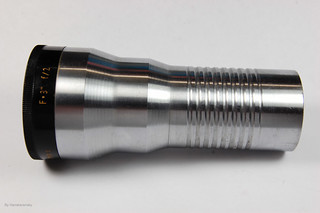Waterworth

|
| Centaur Lens Advt. 1948 scanned by Geoff Harrisson (Image rights) |
Eric Newham Waterworth (1905-1990) was the first of three sons of John Waterworth, an optician who in 1918 founded the firm of Waterworth & Ross in Hobart, Tasmania, Australia. Eric's brother David became an opthalmologist and his other brother Philip an optometrist. Eric, having acquired some engineering design expertise, at the age of 20 invented and patented an automatic record changer. In July 1940 he and Philip were working with a team from the University of Tasmania when they were asked by the Director of Ordnance Production if they could manufacture precision optics for wartime use. They established the Optical Munitions manufacturing facility in Hobart and made many optical products, mainly roof prisms and aerial lenses, during the war years.
At the end of the war the facility was sold to Eric whose new challenge was to develop and produce other products which would be commercially successful. They marketed a Leica style lens, the "Centaur" which was advertised in 1948. Total numbers produced is unknown but serial numbers known range from 106 to 308. A request for projectors from the Department of Visual Aids in the Education Department of Tasmania for school use was the beginning of projector manufacture. The company's most well-known product, it was in production from 1945 to 1963. Various other lenses and optical items were made and the lens coating machine they devised in the 1940s was still in use in the 1960s. The Optical Annexe building in the old University grounds in Hobart is now named the Waterworth Building.

|
| Waterworth 500w Projector c.1959 image by Geoff Harrisson (Image rights) |

|
| Centaur lens 50mm f/3.5 in enlarger mount image by Geoff Harrisson (Image rights) |

|
| Projector Lens f=3" 1:2 image by Hans Kerensky (Image rights) |
Links
- Patents held by Waterworth, at Espacenet, the patent search facility of the European Patent Office:
- British Patent 705026, Improvements in or relating to an optical projection apparatus, filed September 1950 and granted March 1954. This patent describes an episcope (i.e. a projector for showing an enlarged image of a print or document, rather than a transparency, on a screen). The device is arranged with an inclined screen for a single viewer, or a small number of people, rather than projecting on a vertical screen for a large audience.
- British Patent 703729, Improvements relating to stereoscopic viewing instruments, filed November 1950 and granted February 1954. This patent describes a stereo viewer, to be used mostly for viewing aerial survey photographs, illuminated on a horizontal baseboard. The viewer has high- and low-magnification eyepieces, and rhomboid prisms connecting these to the objective lenses, so the photographs can be a convenient distance apart on the board.
- List of patents (search results for 'Waterworth' + 'Eric'), mostly relating to gramophones ('talking machines' in the earlier patents).